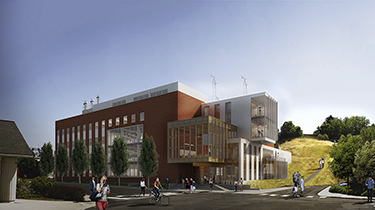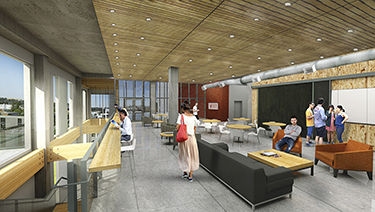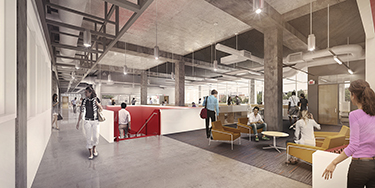|
Subscribe / Renew |
|
|
Contact Us |
|
| ► Subscribe to our Free Weekly Newsletter | |
| home | Welcome, sign in or click here to subscribe. | login |
Construction
| |
 |
August 28, 2014
WSU technology lab combines work with show
LMN Architects

MacDonald
|

Clark
|
The 96,000-square-foot Paccar Environmental Technology Building at Washington State University in Pullman will help the school pursue interdisciplinary research related to sustainability.
The four-story structure for the College of Engineering and Architecture is scheduled to finish construction in September 2015.
LMN and Skanska are delivering the project under a design-build contract — a first for an academic facility at WSU.
The design, which is targeting LEED gold, demonstrates themes of water conservation, daylight access and renewable materials. But the building is also designed to be social and inviting.
The project sets a precedent for the character of the university’s built environment in the 21st century. The 2012 master plan for eastward expansion along Grimes Way calls for densely organized classroom and laboratory buildings, emphasizing a “neighborhood” feel that promotes walkability, street-level encounters and connections to the natural landscape.
The Paccar Environmental Technology Building sits next to the landmark Observatory Hill, mediating between its grassland ecology and the more established area surrounding Martin Stadium. Unlike neighboring structures, the new building is set back only minimally from the street edge, with wide sidewalks along two frontages and a small street plaza at the intersection with Lincoln Drive.
Stormwater from the site passes through permeable pavement and is piped to a series of rain gardens along the Grimes Way sidewalk. Closer to the hillside, plant choices reflect the grasses of the Palouse. Part of the building merges into the slope, creating an earthen roof condition.
Showcase bar
The building serves as both a research laboratory and a public showcase of innovation in action. The architectural concept derives form directly from these two functions, defining a “workhorse bar” housing secure laboratory, office and workstation spaces that are closed to the public, and a “showcase bar” that presents an extroverted face to the campus, inviting the larger community to participate in the life of the program.
The two bars intersect perpendicularly in an L-shape, filling out the street edges of the site while creating an inner courtyard for truck loading and outdoor workspace. The two-level showcase bar is clad primarily in glass and contains two key laboratory spaces that feature work of a visually impactful nature.
The first, at the south end of the bar, is the high-bay Sustainable Infrastructure and Design (SID) lab, with its traveling bridge crane that moves along the ceiling, 25 feet high, supporting hooks capable of lifting 15 tons. The south wall of the lab is a 2-foot thick “strong wall” with a grid of reinforced bolt holes, 2 feet on center, used to anchor material assemblies during breakage testing. The bolt holes continue onto the floor, forming a “reaction floor.”
At the north end of the showcase bar, a transparent wall in the front lobby offers a view of the second showcase lab, the Integrated Design Experience Collaboratory, focused on sustainable infrastructure design. This space functions as a flexible design studio and classroom, offering a constantly changing view. Stepped seating inside and outside of the lobby invites students to congregate and socialize.
As users ascend the main stair to the second level of the showcase bar, they are first treated to a huge floor-to-ceiling window, looking down onto the high-bay volume of the SID lab. The second level opens into a broad cafe and lounge space — often referred to as the town square of the facility.
Here, users experience a heightened sense of centrality and connectedness, with views of the campus, the Palouse, the SID lab and a double-height, glass-enclosed seminar room. The town square is the buzzing social hub of the program, where both researchers and the general public can mingle.
The adjacent seminar room is integrally connected with the town square. Flooded with daylight and views of the campus, cantilevered dramatically over the entry plaza, the room hosts public lectures and presentations while also serving as a multipurpose event space for researchers and staff.
Like all of the showcase bar, the seminar room is framed not with steel but with structural timber — a demonstration of sustainability as well as WSU’s history of innovation in the development of engineered wood building materials, such as glue-laminated beams.
Workhorse bar
From the town square, entry to the workhorse bar — a four-level edifice where the bulk of the program’s research work is done — is restricted by key card. The sense of connectedness does not stop at the security line, however, as daylight and views penetrate throughout the entirety of the workhorse bar’s long, rectangular floor plate, and social activity continues.
The organization of the workhorse bar builds around a central “Main Street,” running the east-west length of the building on three floors. Wet labs are stacked along the south facade, connected via service elevator with the outdoor loading space. Faculty offices are clustered along the north side, overlooking the street.
In between these two clearly defined program blocks, the Main Street zone takes on an informal structure with open workstations for graduate students, team conference areas, casual seating areas and computer simulation labs, all occupying overlapping spatial and visual boundaries.
Each floor of the workhorse bar houses a different research identity: sustainable materials on the ground and second level, water quality on the third level, and air quality on the fourth level and on the roof. Even so, the lab infrastructure is flexible and interchangeable, allowing migration as needed.
To encourage interaction between floors, the Main Street concept extends vertically as well as horizontally, with wide floor openings surrounding crimson-colored open stairwells. Placement of the stairs and openings is staggered to spread their effect over more of the area and create unique patterns of layout and visibility. Researchers in different groups are constantly aware of the other groups working in the building, and have multiple opportunities to pause, share and connect.
Green features
Sense of place — a constant theme throughout the interiors as well as the outdoor public spaces — emerges from a comprehensive analysis of environmental conditions. This includes visual connections to the landscape, social connections between user groups, as well as the physical relationship with the local climate.
Rainwater collected from the roof filters into a below-grade cistern, which is then pumped to a day tank in the town square, supplying 85 percent of non-potable water demand. Quality of daylight is considered from every angle, taking maximum advantage of low-UV northern light with a 50-foot wide, three-story window overlooking the street and clerestory windows on the top level.
Digital modeling determines the form of exterior sunshades — horizontal on the south and vertical on the west — that make panoramic views possible without glare in all seasonal conditions.
In its pursuit of holistic approaches to sustainability research, the Paccar Environmental Technology Building embodies the same approach in its architecture, weaving together multiple site and program influences into a responsive, living whole.
Adrian MacDonald is the communications manager for LMN Architects. Dean Clark is a principal at LMN Architects and the project manager for the Paccar Environmental Technology Building.
Other Stories:
- Can you design a school theater that pleases everyone?
- What schools can learn from Starbucks
- Renton preschool offers kids a running start
- How replacing an old building is like selling New Coke
- Locals designers help rebuild schools in Haiti damaged by earthquake
- What to consider when building a new school next to the old one
- Do art and science mix? Lab designers give it a try





